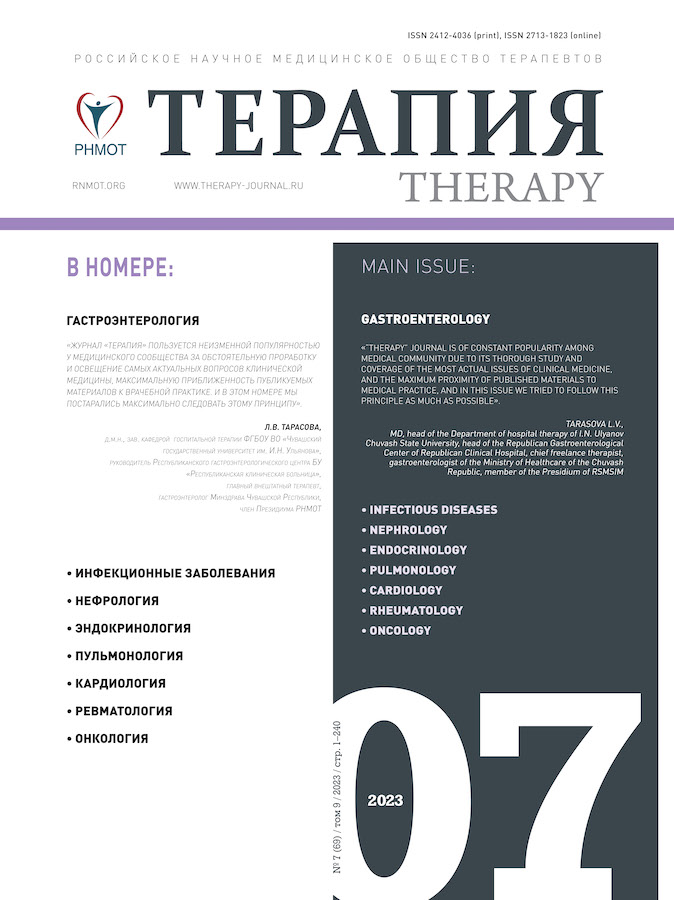Влияние длительной антиаритмической терапии на прогрессирование фибрилляции предсердий от пароксизмальной к постоянной форме
- Авторы: Тарзиманова А.И.1
-
Учреждения:
- ФГАОУ ВО «Первый Московский государственный медицинский университет им. И.М. Сеченова» Минздрава России (Сеченовский Университет)
- Выпуск: Том 9, № 7 (2023)
- Страницы: 208-213
- Раздел: АКТУАЛЬНЫЕ ВОПРОСЫ ФАРМАКОТЕРАПИИ И ПРОФИЛАКТИКИ ЗАБОЛЕВАНИЙ
- URL: https://journals.eco-vector.com/2412-4036/article/view/625444
- DOI: https://doi.org/10.18565/therapy.2023.7.208–213
- ID: 625444
Цитировать
Полный текст
Аннотация
В последние годы было доказано, что существует определенная закономерность при многолетнем течении фибрилляции предсердий (ФП): от бессимптомных, коротких эпизодов аритмии, до устойчивой постоянной формы заболевания, которая создает предпосылки к прогрессированию хронической сердечной недостаточности и значительно ухудшает прогноз пациентов. Продолжительность существования пароксизмальной или персистирующей формы ФП у разных пациентов может варьировать в большом диапазоне – от нескольких месяцев до десятилетий – и взаимосвязана с тяжестью основного заболевания. Пароксизмальная ФП сохраняется в течение многих лет только у небольшой части пациентов. Замедление прогрессирования ФП от пароксизмальной к постоянной форме позволяет улучшить прогноз пациентов, поэтому оценка факторов риска прогрессирования аритмии и назначение правильной тактики ведения пациентов являются актуальными задачами современной кардиологии.
Полный текст
Об авторах
Аида Ильгизовна Тарзиманова
ФГАОУ ВО «Первый Московский государственный медицинский университет им. И.М. Сеченова» Минздрава России (Сеченовский Университет)
Автор, ответственный за переписку.
Email: tarzimanova@mail.ru
ORCID iD: 0000-0001-9536-8307
доктор медицинских наук, профессор кафедры факультетской терапии № 2
Россия, 119048, Москва, ул. Ефремова, д. 24Список литературы
- Hindricks G., Potpara T., Dagres N. et al. 2020 ESC Guidelines for the diagnosis and management of atrial fibrillation developed in collaboration with the European Association for Cardio-Thoracic Surgery (EACTS): The Task Force for the diagnosis and management of atrial fibrillation of the European Society of Cardiology (ESC) Developed with the special contribution of the European Heart Rhythm Association (EHRA) of the ESC. Eur Heart J. 2021; 42(5): 373–498. https://dx.doi.org/10.1093/eurheartj/ehaa612.
- Charitos E.I., Purerfellner H., Glotzer T.V., Ziegler P.D. Clinical classifications of atrial fibrillation poorly reflect its temporal persistence: Insights from 1,195 patients continuously monitored with implantable devices. J Am Coll Cardiol. 2014; 63(25 Pt A): 2840–48. https://dx.doi.org/10.1016/j.jacc.2014.04.019.
- de Vos C.B., Pisters R., Nieuwlaat R. et al. Progression from paroxysmal to persistent atrial fibrillation clinical correlates and prognosis. J Am Coll Cardiol. 2010; 55(8): 725–31. https://dx.doi.org/10.1016/j.jacc.2009.11.040.
- De Vos C.B., Breithardt G., Camm A.J. et al. Progression of atrial fibrillation in the REgistry on Cardiac rhythm disORDers assessing the control of Atrial Fibrillation cohort: Clinical correlates and the effect of rhythm-control therapy. Am Heart J. 2012; 163(5): 887–93. https://dx.doi.org/10.1016/j.ahj.2012.02.015.
- Heijman J., Voigt N., Nattel S., Dobrev D. Cellular and molecular electrophysiology of atrial fibrillation initiation, maintenance, and progression. Circ Res. 2014; 114(9): 1483–99. https://dx.doi.org/1010.1161/CIRCRESAHA.114.302226.
- Veasey R.A., Sugihara C., Sandhu K. et al. The natural history of atrial fibrillation in patients with permanent pacemakers: Is atrial fibrillation a progressive disease? J Interv Card Electrophysiol. 2015; 44(1): 23–30. https://dx.doi.org/10.1007/s10840-015-0029-x.
- Im S.I., Chun K.J., Park S.J. et al. Long-term prognosis of paroxysmal atrial fibrillation and predictors for progression to persistent or chronic atrial fibrillation in the Korean population. J Korean Med Sci. 2015; 30(7): 895–902. https://dx.doi.org/10.3346/jkms.2015.30.7.895.
- Nieuwlaat R., Capucci A., Camm A.J. et al. Atrial fibrillation management: A prospective survey in ESC member countries: The Euro Heart Survey on Atrial Fibrillation. Eur Heart J. 2005; 26(22): 2422–34. https://dx.doi.org/10.1093/eurheartj/ehi505.
- Holmqvist F., Kim S., Steinberg B.A. et al.; ORBIT-AF Investigators. Heart rate is associated with progression of atrial fibrillation, independent of rhythm. Heart. 2015; 101(11): 894–99. https://dx.doi.org/10.1136/heartjnl-2014-307043.
- Lafuente-Lafuente C., Longas-Tejero M.A., Bergmann J.F., Belmin J. Antiarrhythmics for maintaining sinus rhythm after cardioversion of atrial fibrillation. Cochrane Database Syst Rev. 2012; (5): CD005049. https://dx.doi.org/10.1002/14651858.CD005049.pub3.
- Kirchhof P., Lip G.Y., Van Geider I.C. et al. Comprehensive risk reduction in patients with atrial fibrillation: Emerging diagnostic and therapeutic options – a report from the 3rd Atrial Fibrillation Competence NETwork/European Heart Rhythm Association consensus conference. Europace. 2012; 14(1): 8–27. https://dx.doi.org/10.1093/europace/eur241.
- Kirchhof P., Camm A.J., Goette A. et al. Early rhythm-control therapy in patients with atrial fibrillation. N Engl J Med. 2020; 383(14): 1305–16. https://dx.doi.org/10.1056/NEJMoa2019422.
- Миллер О.Н., Старичков С.А., Поздняков Ю.М. с соавт. Эффективность и безопасность применения пропафенона (Пропанорма®) и амиодарона (Кордарона®) у больных с фибрилляцией предсердий на фоне артериальной гипертонии, ишемической болезни сердца и хронической сердечной недостаточности с сохраненной систолической функцией левого желудочка. Российский кардиологический журнал. 2010; 15(4): 55–71. [Miller O.N., Starichkov S.A., Pozdnyakov Yu.M. et al. Effectiveness and safety of propafenone (Propanorm®) and amiodarone (Cordarone®) in patients with atrial fibrillation, arterial hypertension, coronary heart disease, and chronic heart failure with intact left ventricular systolic function. Rossiyskiy kardiologicheskiy zhurnal = Russian Journal of Cardiology. 2010; 15(4): 55–71 (In Russ.)]. EDN: MUENJV.
- Stoschitzky K., Stoschitzky G., Lercher P. et al. Propafenone shows class Ic and class II antiarrhythmic effects. Europace. 2016; 18(4): 568–71. https://dx.doi.org/10.1093/europace/euv195.
- Подзолков В.И., Тарзиманова А.И. Антиаритмическая терапия в лечении фибрилляции предсердий: вчера, сегодня, завтра. Кардиоваскулярная терапия и профилактика. 2019; 18(3): 81–87. [Podzolkov V.I., Tarzimanova A.I. Antiarrhythmic therapy in the treatment of atrial fibrillation: Yesterday, today, tomorrow. Kardiovaskulyarnaya terapiya i profilaktika = Cardiovascular Therapy and Prevention. 2019; 18(3): 81–87 (In Russ.)]. https://dx.doi.org/10.15829/1728-8800-2019-3-81-87. EDN: LYKEFP.
Дополнительные файлы








